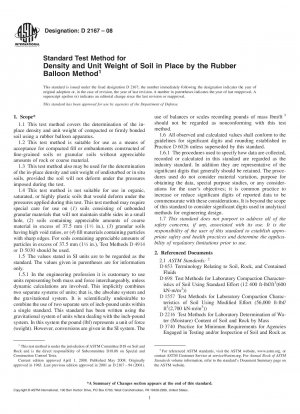ASTM D2167-08
Standard Test Method for Density and Unit Weight of Soil in Place by the Rubber Balloon Method
- Standard No.
- ASTM D2167-08
- Release Date
- 2008
- Published By
- American Society for Testing and Materials (ASTM)
- Status
- Replace By
- ASTM D2167-15
- Latest
- ASTM D2167-15
- Scope
This test method can be used to determine the in-place density and unit weight of natural inorganic soil deposits, soil-aggregate mixtures, or other similar firm materials. It is often used as a basis of acceptance for earthen material compacted to a specified density or percentage of a maximum density determined by a test method, such as Test Methods D 698
, D 1557 or D 4253 . Test Methods D 698
and D 1557 require that mass measurements of laboratory compacted test specimens be determined to the nearest 1 g so that computed water contents and densities can be reported to three and four significant digits, respectively. This standard is a field procedure requiring mass measurements to the nearest 5 g. As such, water content calculations should only be reported to two significant digits and density to three significant digits. This test method may be used to determine the density and unit weight of compacted soils used in construction of earth embankments, road fill, and structural backfill. This test method often is used as a basis of acceptance for soils compacted to a specified density or a percentage of maximum density or unit weight, as determined by a standard test method.
The use of this test method is generally limited to soil in an unsaturated condition and is not recommended for soils that are soft or that deform easily. Such soils may undergo a volume change during the application of pressure during testing. This test method may not be suitable for soils containing crushed rock fragments or sharp edge materials which may puncture the rubber membrane.
Note 18212;Notwithstanding the statements on precision and bias contained in this test method, the precision of this test method is dependent on the competence of the personnel performing it and the suitability of the equipment and the facilities used. Agencies that meet the criteria of Practice D 3740
are generally considered capable of competent and objective testing. Users of this test method are cautioned that compliance with Practice D 3740 does not in itself ensure reliable testing. Reliable testing depends on many factors; Practice D 3740 provides a means of evaluating some of those factors. 1.1 This test method covers the determination of the in-place density and unit weight of compacted or firmly bonded soil using a rubber balloon apparatus.
1.2 This test method is suitable for use as a means of acceptance for compacted fill or embankments constructed of fine-grained soils or granular soils without appreciable amounts of rock or coarse material.
1.3 This test method also may be used for the determination of the in-place density and unit weight of undisturbed or in situ soils, provided the soil will not deform under the pressures imposed during the test.
1.4 This test method is not suitable for use in organic, saturated, or highly plastic soils that would deform under the pressures applied during this test. This test method may require special care for use on (1) soils consisting of unbonded granular materials that will not maintain stable sides in a small hole, (2) soils containing appreciable amounts of coarse material in excess of 37.5 mm (1½ in.), (3) granular soils having high void ratios, or (4) fill materials containing particles with sharp edges. For soils containing appreciable amounts of particles in excess of 37.5 mm (11/2 in.), Test Methods D 4914 or D 5030
should be used. 1.5 T......
ASTM D2167-08 Referenced Document
- ASTM D1557 Standard Test Methods for Laboratory Compaction Characteristics of Soil Using Modified Effort (56,000 ft-lbf/ft3 (2,700 kN-m/m3))
- ASTM D2216 Standard Test Method for Laboratory Determination of Water (Moisture) Content of Soil and Rock by Mass
- ASTM D3740 Standard Practice for Minimum Requirements for Agencies Engaged in the Testing and/or Inspection of Soil and Rock as Used in Engineering Design and Construction
- ASTM D4253 Standard test method for maximum index density and unit weight of soil using a shaking table*, 2024-04-19 Update
- ASTM D4643 Standard Test Method for Determination of Water Content of Soil and Rock by Microwave Oven Heating
- ASTM D4718 Standard Practice for Correction of Unit Weight and Water Content for Soils Containing Oversize Particles
- ASTM D4753 Standard Specification for Evaluating, Selecting, and Specifying Balances and Scales for Use in Soil, Rock, and Construction Materials Testing
- ASTM D4914 Standard Test Methods for Density of Soil and Rock in Place by the Sand Replacement Method in a Test Pit
- ASTM D4944 Standard Test Method for Field Determination of Water (Moisture) Content of Soil by the Calcium Carbide Gas Pressure Tester Method
- ASTM D4959 Standard Test Method for Determination of Water Content of Soil By Direct Heating
- ASTM D5030 Standard Test Method for Density of Soil and Rock in Place by the Water Replacement Method in a Test Pit (Withdrawn 2003)
- ASTM D6026 Standard Practice for Using Significant Digits in Geotechnical Data
- ASTM D653 Standard Terminology Relating to Soil, Rock, and Contained Fluids
- ASTM D698 Standard Test Methods for Laboratory Compaction Characteristics of Soil Using Standard Effort (12 400 ft-lbf/ft3 (600 kN-m/m3))*, 2024-04-19 Update
ASTM D2167-08 history
- 2015 ASTM D2167-15 Standard Test Method for Density and Unit Weight of Soil in Place by the Rubber Balloon Method
- 2008 ASTM D2167-08 Standard Test Method for Density and Unit Weight of Soil in Place by the Rubber Balloon Method
- 1994 ASTM D2167-94(2001) Standard Test Method for Density and Unit Weight of Soil in Place by the Rubber Balloon Method
- 1994 ASTM D2167-94 Standard Test Method for Density and Unit Weight of Soil in Place by the Rubber Balloon Method
